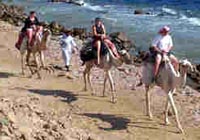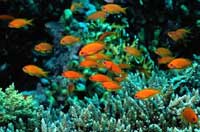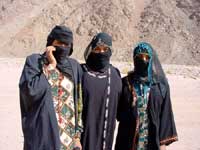|
Abu Galum
 It is located in the north east of south Sinai, near by the Gulf
of Aqaba. It’s area measures 500 square kilometers It is located in the north east of south Sinai, near by the Gulf
of Aqaba. It’s area measures 500 square kilometers
Abu Galum is one of the picturesque nature reserves in the
country. With its high mountains, narrow sinuous valleys (wadis),
freshwater springs, coastal sand dunes, gravel alluvial fans,
raised fossil coral reefs and low lying saline sabkha, it is not
surprising that this small area of the Sinai peninsula houses
165 plant species.
Of these, 44 species are seen only in this reserve and tend to
increase in density towards central and northern Sinai.
 As a floristic frontier, Abu Galum reserve is a sensitive area
that receives a high conservation priority. Access to regions
without vehicle track systems can only be permitted where marked
trails have been prepared. As a floristic frontier, Abu Galum reserve is a sensitive area
that receives a high conservation priority. Access to regions
without vehicle track systems can only be permitted where marked
trails have been prepared.
The managed resource protected area at Abu Galum, covering an
area of 400 km square, protects varied coastal and mountain
ecosystems unique on the Gulf of Aqba.
 The area differs
dramatically from the other reserves on the Gulf. The coastal
area contains undisturbed coral reefs with high diversities of
coral reef fish and associated fauna and flora. Evidence of the
richness of the area could be seen on the shorelines covered
with shells of various mollusk groups. The area differs
dramatically from the other reserves on the Gulf. The coastal
area contains undisturbed coral reefs with high diversities of
coral reef fish and associated fauna and flora. Evidence of the
richness of the area could be seen on the shorelines covered
with shells of various mollusk groups.
The reef at Abu Galum supports an active Bedouin artisanal
fishery. The fishery is now being regulated by Egyptian
Environmental Affairs Authority (EEAA) to reduce damage to the
coral reef. The reef could be viewed at marked, safe access
entry points.
 Terrestrial areas in Abu Galum nature reserve park are a stark
contrast to the exuberance of colour and life seen on the coral
reef. Seemingly devoid of visible life, they are in fact home to
the desert fox, Nubian Ibex (in the mountain areas), numerous
small mammal species, reptiles and insects. Most of this fauna
is difficult to see given their nocturnal habits. Foxes are
often seen in the vicinity of Yolanda Beaches. They are harmless
if approached with care; they should not be fed but can be
provided with water. Fox cubs could be seen at sunset in
springtime. All other wildlife should not be approached. Terrestrial areas in Abu Galum nature reserve park are a stark
contrast to the exuberance of colour and life seen on the coral
reef. Seemingly devoid of visible life, they are in fact home to
the desert fox, Nubian Ibex (in the mountain areas), numerous
small mammal species, reptiles and insects. Most of this fauna
is difficult to see given their nocturnal habits. Foxes are
often seen in the vicinity of Yolanda Beaches. They are harmless
if approached with care; they should not be fed but can be
provided with water. Fox cubs could be seen at sunset in
springtime. All other wildlife should not be approached.
The park is also home to important resident bird populations
including Grey Heron, Goliath Heron, Reef Heron and their small
relative, the Greenback Heron. At least 5 groups pf Osprey (a
fish-eating falcon) are resident and breeding annually. In
summertime thousands of White Stork stop over in the park during
their annual migration to East Africa.
|